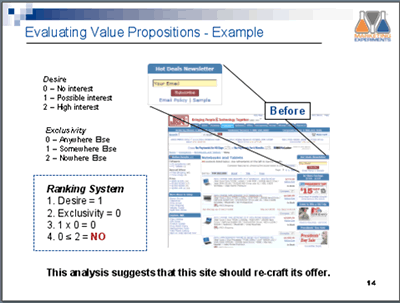Thursday, 16 October 2008
Topic: Powerful Value Propositions: How to Optimize this Critical Marketing Element – and Lift Your Results
Do you think your value proposition is powerful? Would your prospects agree?
Most of the time, when we ask companies about their value proposition, we hear a description of their business model. But that’s not what most customers care about.
Customers not only want to know “What’s in it for me?” but “Why buy from you?”
This is an area that even seasoned marketers have trouble with, because there is so much confusion about what makes a value proposition effective - including how to find one in the first place.
Because value propositions are so important to conversion, making a few small but crucial changes can have a big impact across all of your marketing efforts.
During our September 24, 2008 clinic, we examined why value propositions are so vital to results, presented several ways to significantly improve your value proposition, and reviewed three examples from our workshop participants who optimized their pages with a greater emphasis on these areas.
In addition to the print–friendly research brief below, you can:
Value Proposition Problems That Hold Marketers Back:
Value propositions can be intimidating because they strive to combine small size — often 10 words or less — with a lot of substance. After all, those 10 words are supposed to convey the unique qualities of your company and/or products and services.
No wonder marketers tend to shy away from one of the strongest and lowest cost optimization strategies: re-crafting their value proposition.
Our research shows that most marketers have trouble with the following areas:
- Company has not identified a value proposition
- Company does not clearly express its value proposition
- Company is not testing or measuring its value proposition
These three problems can feed on each other, creating a negative cycle that hurts ROI. In fact, the majority of the 487 marketers we polled during the web clinic said they struggled with all three issues (see poll results).
Key point: To counter these issues, your optimization strategy must include a continuous process of identifying, testing, and expressing value propositions effectively.
Value Propositions: A Major Key to Conversion
What exactly is your value proposition? The primary reason a prospect should buy from you.
When we review the MarketingExperiments Conversion Sequence, it’s easy to see why getting your value proposition right should be a top priority.
 The MarketingExperiments Conversion Sequence
The MarketingExperiments Conversion SequenceWhere C = Conversion, the other sequence elements refer to:
- m – the match between the offer and visitor Motivation.
- v – the clarity of the Value Proposition.
- i – Incentives used to counter Friction.
- f – the level of Friction in the sales process.
- a – Anxiety caused by the process.
While Motivation has the highest coefficient in this formula, it also represents an external factor in the marketing cycle that is beyond your control. That makes the clarity of your Value Proposition the most important internal factor.
However, many marketers try to improve results by changing page elements like font colors and sizes, button shapes, images, incentives, and so on, when the first step should really be focusing on strengthening their value propositions.
Let’s look at a real example.
Example #1: Down & Feather CompanyOriginal Homepage (Detail)
David Smith submitted his site’s homepage for our live optimization web clinic on PPC campaigns in May. He also attended our Landing Page Optimization Workshop in June and worked with our team on ideas for improving the site.
Can you find the value proposition in the original homepage below? Most clinic participants could not.
This is the original value proposition that David submitted for the clinic:
“We don’t harm the birds to acquire the down and we allow our customers the ability to have their pillow firmness adjusted for one year from the date of purchase for FREE. No one else in the industry provides such service. Pillows are very personal and difficult enough to select at a big box retailer much less over the Internet sight unseen. Quite simply the finest down bedding in the world.”
This example underscores the importance of identifying your true value proposition before trying to communicate it. The original homepage did not communicate the stated ideas adequately, much less emphasize them.
The truly unique features of David’s value proposition were buried in a long, complex sentence that probably was skipped over by most visitors. And the customized pillow policy (the true value proposition) was not expressed on the original homepage at all.
However, although the redesigned homepage is still a work in progress, it now puts the primary value proposition in the spotlight.
Redesigned Homepage (Detail)
Key differences in how the value proposition is now expressed include:
- The company’s real value proposition – its “Perfect Pillow Policy” – is now clearly articulated and showcased in a prominent banner on every page.
- “Always Free Shipping” is emphasized (red, placed higher on page), while the credit card and BBB logos are gone from masthead.
- Customer Care section in left navbar reiterates value points.
Comparison: Before and After
While the redesigned page could benefit from further optimization, David confirms that adding and emphasizing the revised value proposition has been a significant factor in improving the site’s conversion rate.
Before we reveal those results, let’s review the essential characteristics of strong value propositions.
Characteristics of Strong Value Propositions
- You must differentiate your offer from your competitors’ offers.
- You may match a competitor on every dimension of value except one.
- You need to excel in at least one element of value.
- In this way you become the best choice for your optimum customer.
- There is a difference between the value proposition for your company and your product. You must address both.
Crafting a value proposition requires substantial reflection on what is unique about your company and your products and services.
Challenge: If you had just 10 words to describe why people should buy from your company instead of another’s, what would you communicate?
Step One: Identifying an Effective Value Proposition
To rate the quality and uniqueness of value propositions, MarketingExperiments uses this 1-5 scale:
- Limited value to a small market. Extensive competition and/or few barriers to entry.
- Substantial value to a medium-sized market. Limited competition and/or significant barriers to entry.
- A product or service with strong product differentiation, but little competitive protection.
- A unique product or service that is highly valuable to a large market, and strong competitive protection and/or extensive barriers to entry. This may take the form of a registered patent or limited access to product components.
- A unique product or service that is highly valuable to a large market, and exclusive or near-exclusive control of essential product components. This may also include a registered patent.
If your value proposition does not rank as a 3 or better on the 1-5 scale, you should take a critical look at your core business to re-craft a value proposition that accurately reflects your capabilities.
Our team also developed a simple system for ranking value propositions to approximate the potential appeal of an offer:
Evaluating Value Propositions
| Desire | Exclusivity |
| 0 - Anywhere Else | 0 - No interest |
| 1 - Somewhere Else | 1 - Possible interest |
| 2 - Nowhere Else | 2 - High interest |
- Rank the ideal customer’s desire level for the offer.
- Rank the exclusivity of the offer.
- Multiply the two integers.
- If the total is less than 2, re-craft your offer.
Evaluating Value Propositions–Example (Before and After)
Step Two: Expressing Your Value Proposition
Having a powerful value proposition is not enough; it must be communicated effectively to achieve optimal results.
First, you need to refine your value proposition until you can articulate it in a single, instantly credible sentence.
When that is accomplished, you can optimize your pages to express and support the value proposition using congruence.
What is congruence? It refers to having every element of your page either state or support the value proposition
Let’s look at two other examples from workshop attendees to illustrate the concept of congruence:
Example #2: University of New England Original Landing Page (Detail)Matt Celano also attended our Landing Page Optimization Workshop in June and worked with our team on ideas for revising this landing page.
Before showing the revised page, we asked clinic participants to identify the value proposition. Here are some of the more common responses:
- “On-line degree?”
- “Too much text on the page to find it.”
- “Master’s programs”
- “Concentration relevant to your classroom.”
Optimized Version (Detail)Key differences in how the value proposition is now expressed include:
- Stronger intro copy. Descriptive subheads do a better job of expressing the value proposition.
- Cleaner masthead image conveys end result of the degree, rather than features of the campus (not relevant for online coursework)
- Prominent credibility indicators (US News rank and badge) support the value proposition.
Example #3: Co-BrandNews.com Original Landing Page (Detail)Eric Stevenson submitted this page for our February web clinic. He later applied several of the recommendations from our optimization team.
Before showing the revised page, we asked clinic participants to identify the value proposition. Here are some of the more common responses:
- “News your way.”
- “Add Co-Brand and increase web traffic”
- “Sign-up to add Co-Brand News to your website for free.”
- “Give your website the personal attention it needs.”
Optimized Version (Detail)Key differences in how the value proposition is now expressed include:
- Cleaner copy throughout the page, starting with the standout headline
- Subheads, bullet points, calls to action–all work together to support the value proposition
- Testimonial addresses flexibility, customization–a key value point
- Free offer emphasized
David, Matt and Eric all used congruence to revise their copy and design elements, and present a more direct message focused on the uniqueness and credibility of their value proposition.
As clinic attendees pointed out, some value propositions were already in there, but not fully expressed. Sometimes re-crafting a value proposition is simply a matter of reorganizing the information already expressed.
Step Three: Testing Your Value Proposition
However hard you work on expressing your value proposition, to know its true effectiveness you must test to see how it resonates with your ideal prospect.
Two methods to consider are micro-testing and radical redesign testing.
Micro-testing Your Value Proposition
To discover language that best expresses your value proposition, you can micro-test using PPC ads. In a sense, micro-testing is a preliminary test to determine whether your new value proposition is clearly identified and expressed.
With micro-testing, you can explore whether your re-crafted value proposition merits a radical redesign of your pages or if you must re-engage with the processes of identification and expression.
Create 3-5 variations of PPC ads using your summary value proposition and measure the clickthrough rate of each ad. The ad with the highest clickthrough rate identifies the value proposition that’s most appealing to potential customers.
Example: Value proposition micro-test for an ISO Business:
“Radical Redesign” Testing of Value Propositions
If your landing pages or sites have limited traffic, testing the application of your value proposition with congruence using single-factorial methods (A/B tests) can be time-consuming and cumbersome.
One way to counter this is by using radical redesign tests to achieve initial results quickly, and point out specific areas for additional tests.
The three landing page examples above from our workshops and clinics have all used a radical redesign (multivariable) testing strategy.
Due to the nature of these tests, it is impossible to isolate and attribute all gains or losses specifically to the value proposition alone. However, optimizing pages with a focus on congruence and effectively expressing a more powerful value proposition is a major factor, as indicated by the conversion sequence.
With that caveat in mind, let’s look at the results of the three pages that were optimized and tested using the radical redesign approach.
Results: Before and After
The optimized version of this page increased conversion rate by 145%. (David Smith, Down & Feather Company)
The optimized version of this page increased conversions by 300% and conversion rate by 81%. (Matt Celano, Compass Knowledge Group)
The optimized version of this page increased conversions by 200% and conversion rate by 69%. (Eric Stevenson, Co-Brand News)
How These Tests Work Together
While micro-testing with PPC ads can help you find the language that best expresses your value proposition, radical redesign testing can help you optimize pages for congruence and achieve initial results quickly, while pointing to specific areas for additional testing.
In other words, these two tests can help you focus on using your value proposition to give customers the right support at the right time.
Powerful Value Propositions- Your value proposition is the primary reason a prospect should buy from you.
- Optimizing value propositions is a continual process that involves identifying, expressing, and testing/measuring.
- To express your value proposition effectively, pay attention tocongruence.
- Micro-testing with PPC ads can help you find the language that best expresses your value proposition.
- Radical redesign tests can achieve initial results quickly, and identify areas for additional testing.
Related Marketing Experiments Reports
As part of our research, we have prepared a review of the best Internet resources on this topic. Rating System
These sites were rated for usefulness and clarity, but alas, the rating is purely subjective.
* = Decent | ** = Good | *** = Excellent | **** = Indispensable
Credits:
Managing Editor — Hunter Boyle
Copy Editor — Frank Green
Writer — Anna Jacobson
Contributor(s) — Flint McGlaughlin
Bob Kemper
Production — Mel Harris
Austin McCraw
Cliff Rainer
Amanda Mehlhoff
출처: http://www.marketingexperiments.com/improving-website-conversion/powerful-value-propositions.html
 WhyCustomerValuePropositionsReallyMatter.pdf
WhyCustomerValuePropositionsReallyMatter.pdf









































